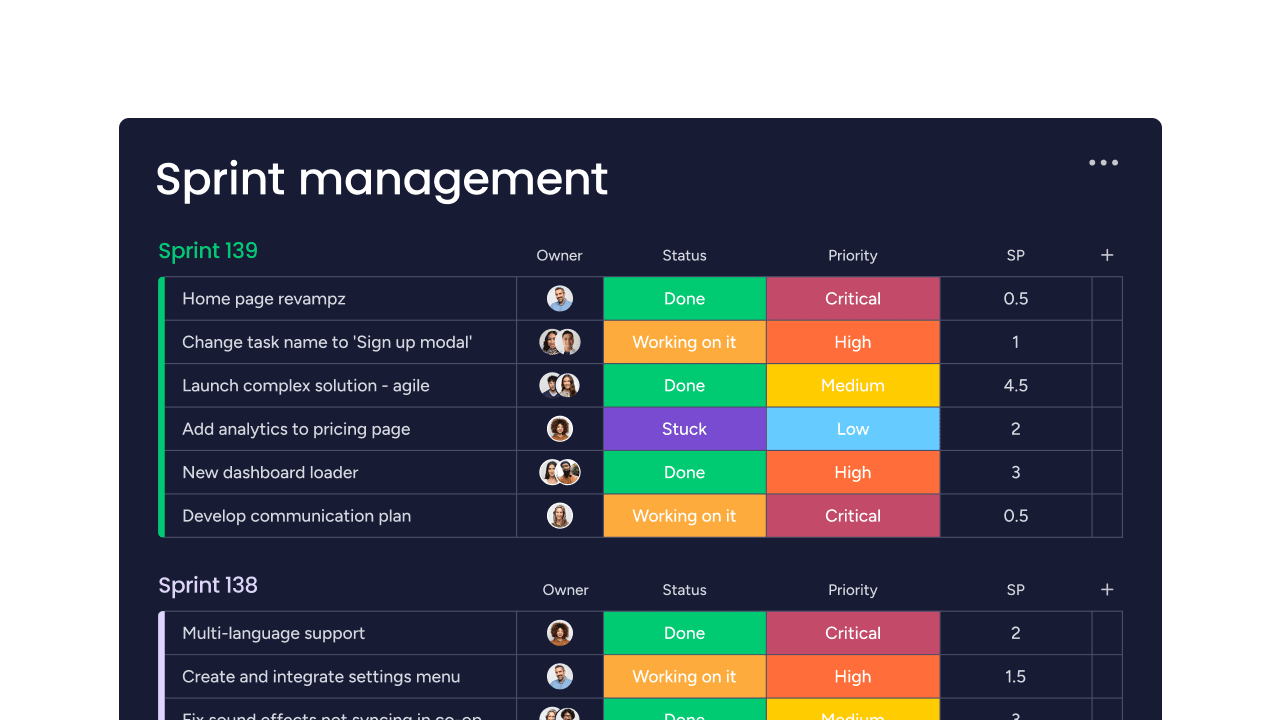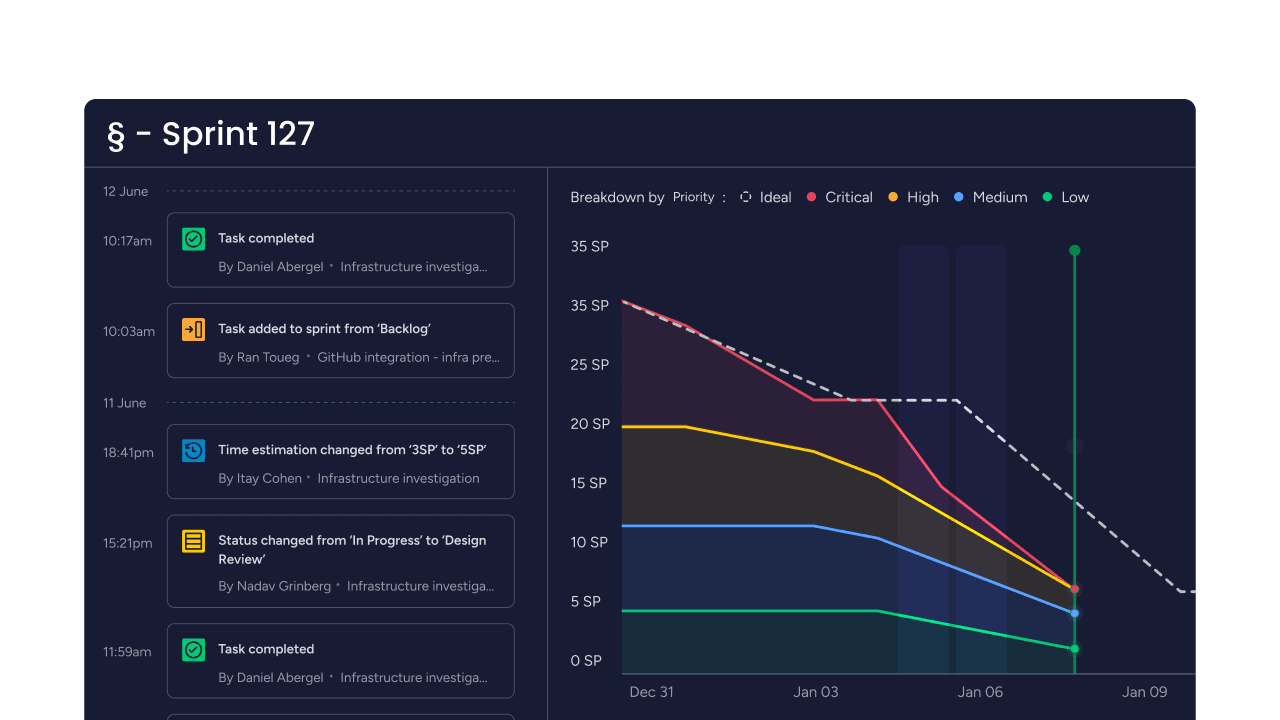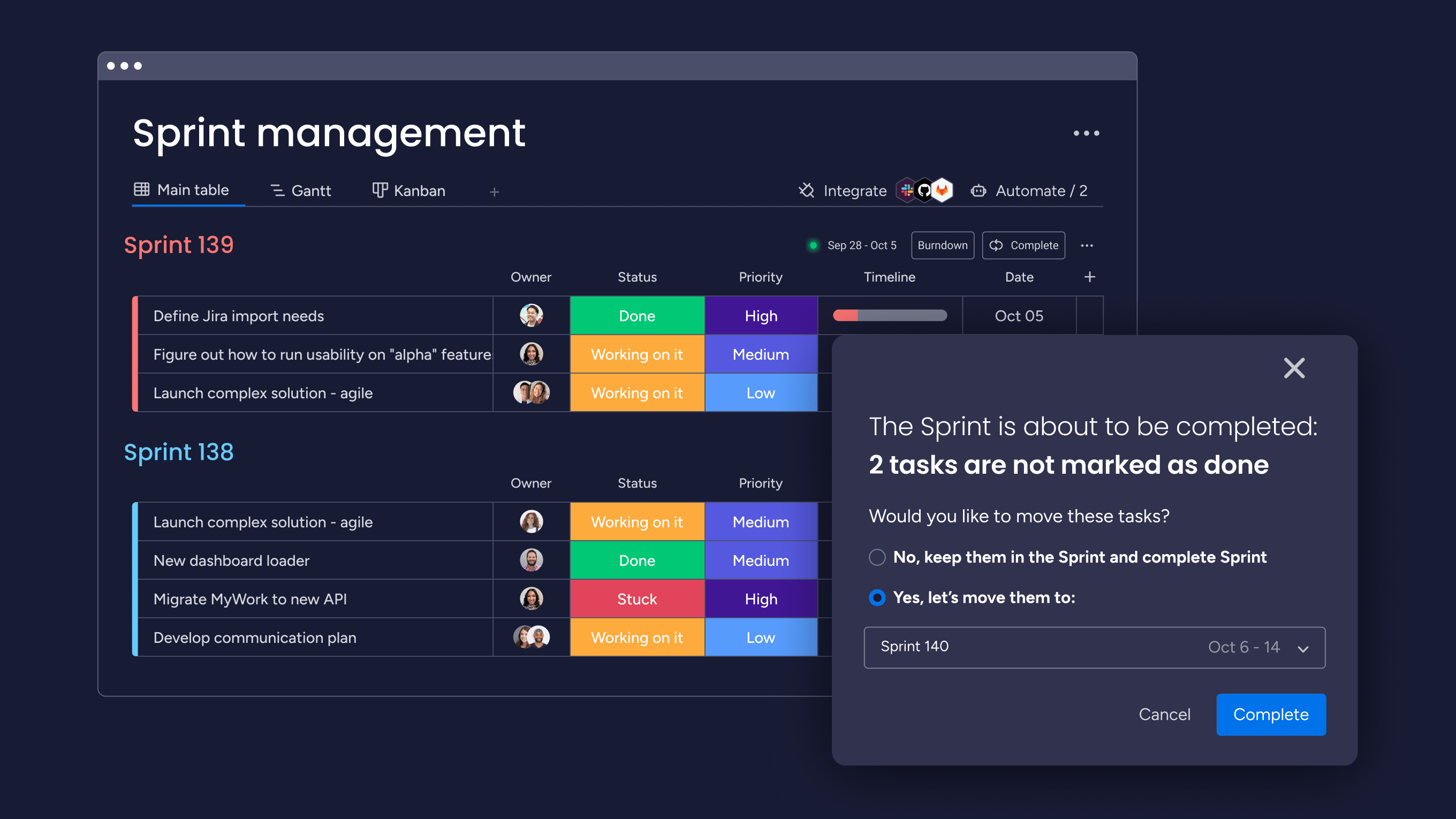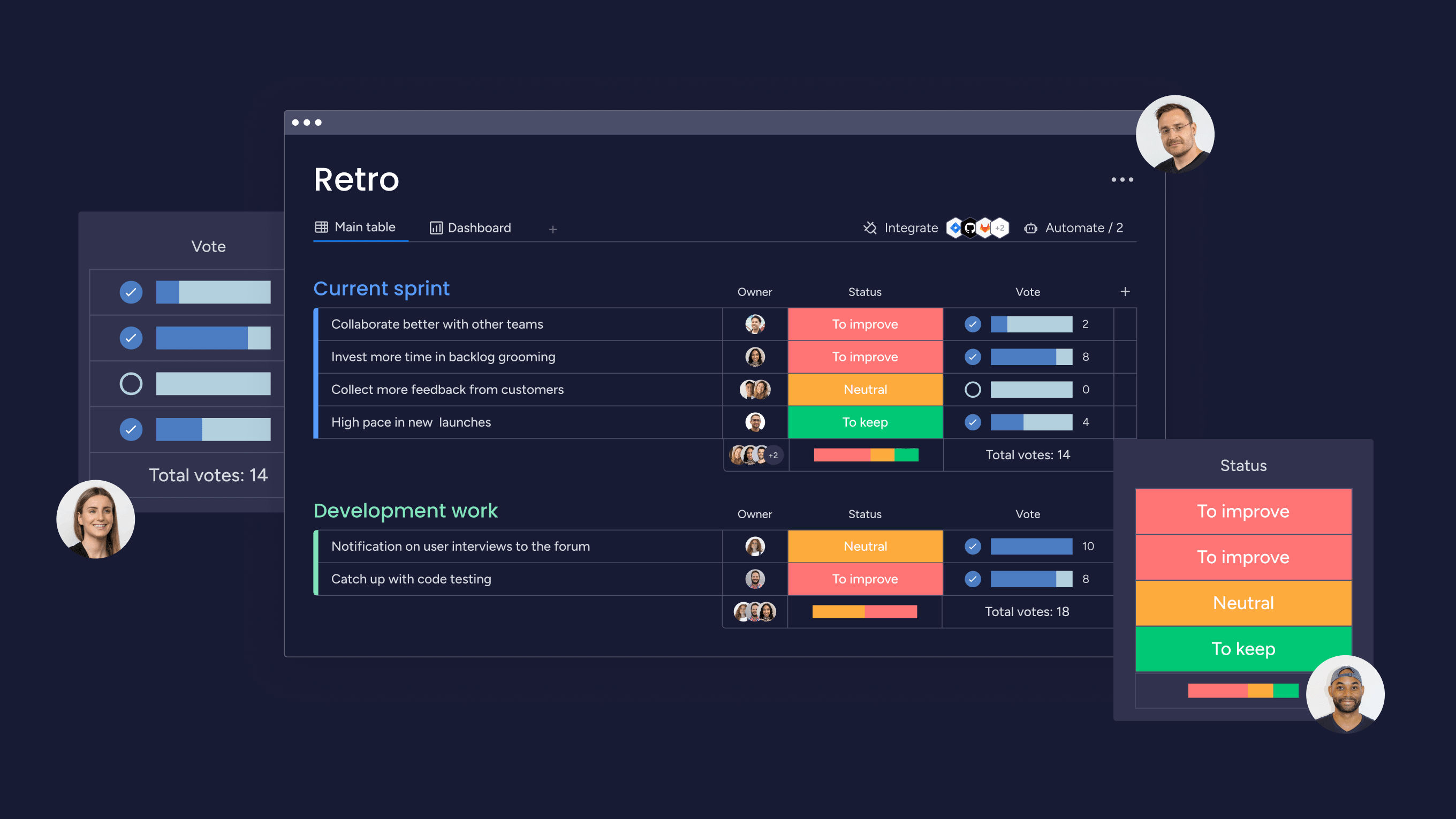Development teams face a fundamental choice. Do you build with a complete blueprint, where every detail is planned upfront for maximum predictability? Or do you build a working version first and adapt it based on real feedback, prioritizing speed and flexibility?
This decision between traditional and Agile approaches shapes how you ship products, collaborate across departments, and ultimately deliver value.
This helpful post breaks down the core principles of both methodologies. It explores the key differences in detail, from planning and scope to team structure and delivery. The goal is not to declare a winner, but to help you build a process that provides structure without sacrificing speed, creating a system that truly fits your team and project needs.
Let’s dive in!
Key takeaways
- Choice must fit the project: traditional works best for well-defined requirements, fixed budgets, and regulatory compliance. Agile excels when requirements evolve, and rapid adaptation and speed matter most.
- Delivery frequency: Agile delivers working features every sprint, enabling early customer feedback and reducing risk. Traditional delivers everything in a single release at the end, providing predictable timelines.
- Hybrid is often best: hybrid strategies often work best, combining the oversight of traditional governance with the speed and flexibility of Agile delivery.
- Platform adaptability: modern platforms like monday dev adapts to any methodology you choose (traditional, Agile, or hybrid). It allows you to create custom workflows, track progress your way, and maintain real-time visibility without forcing a process change.
- Team and culture: small, experienced teams thrive with Agile’s flexibility, while large or distributed teams often require the clear structure and defined roles of a traditional approach.
What is traditional project management?
Traditional project management follows a linear, sequential approach where each phase completes before the next begins. Teams move through distinct stages, from initiation to closure, in a predetermined order. This methodology relies on comprehensive upfront planning, detailed documentation, and formal processes to guide projects from start to finish.
The traditional methodology is comparable to building a house. Complete blueprints are required before laying the foundation, and the roof cannot be installed until the walls are up. Each phase depends entirely on the previous one being finished.
Core principles of traditional methodology
Traditional project management is built on structure and predictability. Its core principles create a controlled environment where teams follow a defined plan, move through formal stages, and manage change carefully to keep projects on track.
- Predictability through planning: detailed upfront planning minimizes surprises and creates clear roadmaps
- Hierarchical decision-making: clear chains of command ensure accountability and proper oversight
- Phase gate reviews: formal checkpoints validate progress before moving to the next stage
- Controlled change management: structured processes protect project scope and budget from unplanned changes
Traditional project management phases
Every traditional project moves through five distinct phases. Each phase has specific deliverables and gates that teams must pass through:
- Initiation: define the project charter and identify key stakeholders.
- Planning: create detailed schedules, budgets, and resource allocation plans.
- Execution: build deliverables according to the approved plan.
- Monitoring and controlling: track progress and manage variances from the plan.
- Closure: complete final deliverables and document lessons learned.
Common traditional frameworks
Several established frameworks embody the principles of sequential and predefined project management. These methodologies offer specific structures and controls for organizations that prioritize strict planning and predictability:
- Waterfall: projects flow downward through phases like water over a cliff.
- Critical Path Method (CPM): identifies the longest sequence of dependent activities.
- PRINCE2: provides structured roles and processes for project governance.
- PMBOK Guide: offers comprehensive standards across all project knowledge areas.

What is Agile project management?
Agile project management uses short, iterative cycles to deliver working products quickly. Instead of planning everything upfront, teams work in one to four week sprints, adapting as they learn, which aligns with Agile software development practices. This approach values flexibility and customer feedback over following a fixed plan.
Picture developing a mobile app. Rather than spending months planning every feature, you build a basic version, get user feedback, and improve it sprint by sprint, embodying an Agile development process. Each iteration delivers something valuable to users.
Core Agile principles and values
Agile is guided by four core values outlined in the Agile Manifesto. These principles shift the focus from strict documentation and planning to rapid delivery and continuous adaptation.
- People over processes: team collaboration matters more than following procedures.
- Working products over documentation: delivering functional software beats writing reports.
- Customer collaboration over contracts: ongoing partnership trumps negotiated agreements.
- Responding to change over plans: adapting quickly provides more value than sticking to outdated plans.
Popular Agile frameworks
Several popular frameworks exist to help organizations implement the Agile principles effectively. Each one offers a specific set of practices, roles, and ceremonies.
- Scrum: uses fixed-length sprints with specific roles and ceremonies.
- Kanban: visualizes workflow and limits work in progress.
- Lean: eliminates waste and maximizes customer value.
- Extreme Programming (XP): emphasizes technical excellence and frequent releases.
Agile project management roles
Agile teams organize around three key Agile roles that share responsibility for success. These roles collaborate closely rather than working in silos:
- Product Owner: represents the customer and prioritizes what to build.
- Scrum Master: facilitates the process and removes obstacles.
- Development Team: cross-functional group that builds the product.
7 key differences between traditional and Agile project management?
How do these two approaches actually differ in practice? Understanding these distinctions helps you choose the right method for your projects. Let’s explore the key differences that impact how teams work and deliver value.
1. Flexibility and adaptability
Traditional project management treats changes as disruptions. Any scope change requires formal approval, impact analysis, and often budget increases. This protects the original plan but can slow responses to new opportunities.
Agile embraces change as normal. Teams expect requirements to evolve and build flexibility into their Agile workflow. When priorities shift, they can pivot within days rather than weeks.
2. Project requirements and scope
Traditional methods define all requirements upfront. Business analysts spend weeks documenting every detail before development starts. This works when requirements are stable and well-understood.
Agile starts with high-level goals and refines details through each sprint. Requirements evolve based on user feedback and market changes. This ensures the final product meets actual needs, not initial assumptions.
3. Communication and collaboration
Traditional projects use formal communication channels. Status reports flow up the hierarchy, and decisions come down through official channels. Project managers coordinate between teams and stakeholders.
Agile teams communicate constantly through daily standups and collaborative workspaces. Information flows freely, and everyone has visibility into progress. monday dev supports both styles with customizable dashboards and automated updates, providing robust Agile project management software capabilities.
4. Planning and documentation
Traditional approaches invest heavily in upfront planning. Teams create detailed specifications, design documents, and project plans before starting work. This documentation serves as a contract between stakeholders.
Agile uses just-enough Agile planning and documentation. Teams focus on user stories and acceptance criteria rather than comprehensive specifications. Planning happens continuously throughout the project.
5. Change management approach
Traditional methodologies handle changes through formal control boards. Each change requires documentation, analysis, and approval — a process that can take weeks.
Agile expects and welcomes change. Teams review priorities each sprint and adjust based on new information. This flexibility enables rapid response to market shifts.
6. Team structure and roles
Traditional projects use specialized roles in hierarchical structures. Developers code, testers test, and project managers coordinate. Decision-making follows the chain of command.
Agile teams are cross-functional and self-organizing. Members collaborate across disciplines and share accountability for outcomes. Teams make decisions collectively within agreed constraints.
7. Delivery timeline and iterations
Traditional projects deliver everything at the end. Stakeholders wait months or years to see working functionality. This creates risk if the final product doesn’t meet expectations.
Agile delivers working features every sprint. Stakeholders see progress continuously and provide feedback that shapes future development. This reduces risk and ensures alignment with user needs.

Traditional project management vs Agile methodology: comparison table
To see how these two approaches differ in practice, the table below highlights how each one handles planning, communication, team structure, delivery, and more.
| Aspect | Traditional project management | Agile project management |
|---|---|---|
| Approach | Sequential phases | Iterative sprints |
| Planning | Comprehensive upfront | Continuous adaptation |
| Requirements | Fixed specifications | Evolving user stories |
| Team structure | Hierarchical, specialized | Cross-functional, collaborative |
| Communication | Formal reporting | Daily collaboration |
| Documentation | Exstensive | Just enough |
| Customer involvement | Beginning and end | Throughout the project |
| Change handling | Formal control process | Built into each sprint |
| Delivery | Single release at completion | Frequent incremental releases |
5 benefits of Agile project management
Why do organizations choose Agile? The benefits go beyond just faster delivery. Agile transforms how teams work together and deliver value to customers.
1. Faster time to market
Agile teams release features as soon as they’re ready, so you don’t wait for the entire project to finish before delivering value. In fact, studies show that Agile organizations have, on average, a 37% faster time to market than their competitors. This means revenue starts flowing sooner and customers get solutions faster.
2. Improved team collaboration
Agile’s structure is specifically designed to eliminate organizational bottlenecks and empower team members through daily interaction:
- Breaks down silos: cross-functional Agile teams (developers, designers, business analysts) work together daily, which speeds up decision-making and reduces miscommunication.
- Boosts engagement: team members report higher job satisfaction because they see their direct impact on the customer and have input into planning.
- Quantifiable results: according to a McKinsey study cited by Planview, Agile organizations see a 20- to 30-point improvement in employee engagement.
3. Greater flexibility to changes
Market conditions change quickly. Agile teams can pivot based on new information without derailing the entire project. Short sprints mean you’re never more than a few weeks from changing direction.
This adaptability reduces the risk of building products nobody wants. You can test assumptions early and adjust based on real data.
4. Enhanced customer satisfaction
Customers see progress regularly and influence the product’s direction. Their feedback shapes each sprint, ensuring the final product meets their actual needs.
Regular demonstrations also build trust. Customers appreciate being heard and seeing their suggestions implemented quickly.
5. Continuous improvement focus
Agile teams hold retrospectives after each sprint to identify what’s working and what isn’t. This creates a culture of learning and experimentation.
Teams get more effective over time. They identify patterns, streamline processes, and embrace Agile best practices to continuously raise their performance bar.
5 benefits of traditional project management
When does traditional project management shine? Despite Agile’s popularity, traditional approaches offer distinct advantages in specific situations.
Understanding the benefits below will help you recognize when structure and predictability matter most.
Clear project structure and predictability
Traditional project management provides certainty that many organizations need. Defined phases and milestones make it easy to coordinate resources and plan budgets. You know exactly what will be delivered and when.
This predictability helps with strategic planning. Organizations can schedule multiple projects and allocate resources confidently.
Comprehensive documentation
Detailed documentation serves multiple purposes beyond just planning. It ensures compliance with regulations, helps new team members understand decisions, and provides references for future projects.
In regulated industries, this documentation is essential. It demonstrates adherence to standards and provides audit trails for compliance reviews.
Defined roles and responsibilities
Clear accountability prevents confusion about who does what. Each team member knows their specific responsibilities and reporting relationships. This clarity reduces conflicts and improves coordination.
Specialized roles also allow deep expertise development. Team members can focus on their strengths and contribute most effectively.
Strong risk management
Traditional approaches identify and plan for risks before they occur. Teams analyze potential problems, develop mitigation strategies, and monitor risk indicators throughout the project.
This proactive approach prevents many issues from becoming crises. It’s especially valuable for high-stakes projects where failure would have serious consequences.
Budget and timeline control
Fixed scope and detailed planning enable accurate cost management. Organizations can commit to budgets and deadlines with confidence. This control is crucial when projects must integrate with other initiatives.
The emphasis on planning also prevents scope creep. Clear boundaries protect projects from expanding beyond their original intent and budget.

When to use traditional vs Agile project management
Choosing the right approach isn’t about following trends — it’s about matching methodology to your specific situation. Let’s explore when each approach works best.
Best scenarios for traditional project management
Traditional project management excels when you have clarity and stability. These conditions allow detailed planning to provide real value, especially for project management in software engineering:
- Well-defined requirements: building a bridge or implementing an ERP system with clear specifications.
- Regulatory compliance: healthcare systems or financial platforms requiring extensive documentation.
- Large, complex projects: multi-year initiatives with numerous dependencies and stakeholders.
- Fixed constraints: government contracts with non-negotiable budgets and deadlines.
Best scenarios for Agile project management
Agile thrives in uncertainty and change. These environments benefit from flexibility and rapid learning:
- Evolving requirements: new product development where user needs aren’t fully understood.
- Competitive markets: digital products requiring quick adaptation to market changes.
- Innovation projects: experimental initiatives exploring new technologies or markets.
- Collaborative teams: small to medium groups that can make decisions quickly.
Project characteristics that drive methodology choice
Several factors influence which approach fits best. Consider these characteristics when making your decision:
Project size affects coordination needs. Large projects with many teams often benefit from traditional structure. Smaller projects can move faster with Agile flexibility.
Risk tolerance shapes methodology choice. Organizations that can’t afford failure may prefer traditional planning. Those willing to experiment benefit from Agile’s iterative approach.
How to choose between traditional and Agile methodologies
Making the right choice requires systematic evaluation. Follow these steps to select the methodology that best fits your situation:
Step 1: assess your project requirements
- Requirements clarity: examine how well you understand what needs to be built now (fixed requirements vs. requirements that emerge through discovery).
- Compliance needs: look at your compliance and documentation needs. Regulated industries often require the extensive documentation that traditional approaches provide.
- Timeline and budget: consider your flexibility. Fixed deadlines and budgets may require traditional planning, while flexible projects can adapt using Agile approaches.
Step 2: evaluate team capabilities
- Size and experience: small, experienced teams can self-organize effectively using Agile. Conversely, large or inexperienced teams may require the structure of a traditional methodology.
- Geographic distribution: co-located teams collaborate easily using the frequent, informal practices of Agile. Distributed teams might benefit from the more formal coordination methods found in traditional approaches.
- Comfort with ambiguity: consider your team’s preference for detail. Agile requires making decisions with incomplete information, which some teams thrive on, while others strongly prefer clear, upfront specifications.
Step 3: consider organizational culture
- Decision-making: examine how your organization makes decisions. Fast, decentralized decision-making supports Agile. Hierarchical structures align with traditional methods.
- Existing governance: look at existing processes and governance. Organizations with established Project Management Offices may find traditional approaches easier to implement initially.
- Appetite for change: adopting Agile often requires significant cultural shifts that not all organizations are ready to make.
Step 4: analyze stakeholder expectations
- Involvement preference: understand how stakeholders want to be involved (detailed upfront plans vs. continuous collaboration and frequent demonstrations).
- Availability: assess stakeholder availability. Agile requires regular, frequent involvement, while traditional approaches work with less frequent touchpoints.
- Success metrics: consider what defines success. Traditional approaches provide detailed progress tracking. Agile focuses on delivered functionality and business value.

Combining traditional and Agile approaches
What if you need both structure and flexibility? Many organizations succeed by blending methodologies. This hybrid approach leverages strengths from both worlds.
Hybrid project management strategies
One effective hybrid uses traditional governance with Agile delivery. Leadership gets the oversight they need while teams work with Agile flexibility. monday dev supports this approach with customizable workflows accommodating both styles.
Another approach applies traditional planning to project structure while using Agile for execution. Create milestone schedules traditionally, then deliver each phase using Agile sprints.
Some organizations use different methodologies for different project phases. Requirements gathering might follow traditional methods, while development uses Agile practices.
Transitioning between methodologies
Organizations often begin an Agile transformation gradually. Start by introducing Agile practices within traditional projects. Use daily standups during execution phases. Conduct retrospectives after milestones.
Pilot Agile on lower-risk projects first. Build skills and confidence before applying Agile to critical initiatives. This reduces disruption while developing capabilities.
Document lessons learned during the transition. Share successes and challenges across teams to accelerate organizational learning.
Managing mixed methodology teams
Coordinating teams that use different methodologies (Hybrid approach) requires establishing specific protocols to ensure seamless workflow and visibility:
- Standardize reporting: establish clear communication protocols and common reporting formats that work for both traditional and Agile approaches.
- Create integration points: set up focused meetings where teams align on dependencies and deliverables, prioritizing shared outcomes over methodology-specific practices.
- Use flexible platforms: utilize solutions, such as monday dev, that support both methodologies. This allows teams to work their preferred way while maintaining unified visibility across the entire organization.
How monday dev bridges traditional and Agile project management
Flexible solutions like monday dev adapt to how your team works, not the other way around. Built on the robust Work OS foundation, the platform allows you to implement any methodology effectively, providing the flexibility needed for your specific process.
Flexible workflows for any methodology
Create boards that match your exact process. Traditional teams can set up phase gates, approval workflows, and milestone tracking. Agile teams configure sprint boards, backlogs, and burndown charts.
Pre-built templates help you start quickly. Choose traditional project plans or Agile frameworks, then customize to fit your needs. Automation works with any approach, reducing manual work regardless of methodology.
Teams can even mix approaches on the same board. Track traditional milestones while managing Agile sprints, all in one place.
Real-time visibility across teams
Dashboard views work for any methodology. Traditional teams track milestone progress and budget variance. Agile teams monitor velocity and sprint burndown. Leadership sees everything in formats they understand.
Portfolio dashboards aggregate data from multiple projects. Get executive visibility without forcing teams to change how they work. Real-time updates eliminate manual reporting and status meetings.
Custom views let each stakeholder see what matters to them. Developers focus on sprint tasks while executives track strategic alignment.
Seamless integration with your tech stack
Connect traditional planning platforms like Microsoft Project alongside Agile platforms like Jira. Information flows automatically between systems without manual synchronization.
Development platforms like GitHub integrate directly. Code commits link to project tasks regardless of methodology. This creates traceability from strategic plans to technical implementation.
Enterprise system integrations ensure hybrid approaches work with existing infrastructure. Your methodology choice doesn’t limit your platform options.

Transform your project management approach with monday dev
The best project management approach is the one that fits your specific situation. Whether you need traditional structure, Agile flexibility, or a hybrid blend, success comes from aligning methodology with your project characteristics, team capabilities, and organizational culture.
Solutions like monday dev empower teams to work their way. The platform’s flexibility means you’re not locked into a single approach. Start with what works today and evolve as your needs change. Teams focus on delivering value while the platform handles the process complexity.
Ready to see how monday dev can transform your project management? Experience the flexibility to work your way, whether traditional, Agile, or anywhere in between.
Frequently asked questions
What is the main difference between traditional and Agile project management approaches?
The main difference between traditional and Agile project management is that traditional follows a sequential process where each phase completes before the next begins, while Agile uses iterative cycles delivering working functionality every one to four weeks. Traditional emphasizes upfront planning and documentation, while Agile prioritizes flexibility and continuous stakeholder collaboration.
Can traditional project management and Agile methodologies be used together?
Yes, traditional and Agile can be combined through hybrid approaches. Organizations commonly use traditional governance with Agile delivery methods, or apply traditional planning at the project level while using Agile for execution phases.
Which project management approach costs more to implement?
Implementation costs vary by organization and project type. Traditional approaches may require higher upfront planning investment, while Agile may need training and cultural change investment. The real cost depends on your specific context and current capabilities.
How long does it take to transition from traditional to Agile project management?
Transitioning from traditional to Agile typically takes 6-18 months, depending on organization size and commitment. Success comes from gradual implementation through pilot projects rather than attempting immediate wholesale changes.
What types of projects work best with traditional project management methods?
Traditional project management works best for projects with well-defined requirements, regulatory compliance needs, fixed budgets and timelines, and complex dependencies. Construction, aerospace, healthcare, and government contracting often benefit from traditional structure.
Is Agile project management suitable for large enterprise projects?
Yes, Agile can work for large enterprise projects through scaled frameworks like SAFe or LeSS. These frameworks coordinate multiple Agile teams while maintaining flexibility and responsiveness for complex initiatives.
 Get started
Get started 


